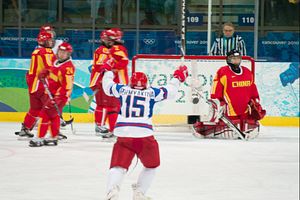On September 1, 2016 history will be made when Red Star Kunlun, the Beijing-based ice hockey team that recently joined the Russian-based Kontinental Hockey League (KHL), plays its first match against Amur in the Russian Far Eastern city of Khabarovsk. It will mark China’s entry into the world of top-level ice hockey, and the KHL’s boldest move yet in its quest to expand beyond Russia and the former Soviet Union. The question remains though of whether the Chinese will embrace the sport, or if the KHL is being too ambitious.
It should be clarified that ice hockey is not an alien sport to China, though it is far from a popular one. China has been a member of the International Ice Hockey Federation (IIHF), the global governing body of ice hockey, since 1963, and has participated in the annual World Championship since 1972 (though they have only regularly played since 1989). There is also a Chinese-based team, the China Dragon, in the Asia League Ice Hockey (ALIH), which also includes teams from Japan, South Korea, and Sakhalin Island in Russia. And indeed, China Dragon, who are nominally based out of Shanghai but play matches in several cities, saw the highest average attendance among the entire ALIH in the 2015-16 season, with 1,526 spectators per match, compared to 940 per match for the league.
However the number of Chinese playing hockey, as registered to the IIHF, is staggeringly low. There were a total of 1,225 players counted in 2016, a number that includes both men and women, senior and junior; when looking just at senior men’s players, there is only 200 registered. When one considers that countries like New Zealand (665 senior male players), Mexico (243), or even the United Arab Emirates (342) have more players than China, it seems like there is much to be desired in China.
The hope is that the formation of Red Star Kunlun will spur development. This is especially important given that Beijing is set to host the 2022 Winter Olympics. As the host nation, China is given automatic qualification into every event, which includes ice hockey. However the current IIHF world ranking has China ranked 37 out of 51 countries; in contrast the lowest ranked team at the 2014 Olympics, Austria, is currently 17th. There was also considerable discussion amongst the IIHF of whether to allow South Korea, who is hosting the 2018 Olympics in Pyeongchang, an automatic berth. South Korea currently sits 23rd in the world.
The case of South Korea is important here, and may serve as a template for China to follow. Over the past several years several North Americans playing for teams based in South Korea have been granted South Korean citizenship, so that they may be eligible to join the national team and help improve their prospects at the Olympics. That said, the players who have been naturalized (there were five on the 2016 World Championship roster) are not of the top quality (only one of them, Bryan Young, played any games in the National Hockey League, the top league in the world), and since 2011 (when Pyeongchang was announced as the host city), South Korea’s world ranking has only moved up two spots.
Of course the difference here is that Red Star Kunlun is not just playing in the ALIH, but instead against what is arguably the second best league in the world. A quick glance through the rosters of many KHL teams shows some of the top names in ice hockey, the vast majority of them naturally Russian but many others from Europe and North America as well. With plans to have a fair number of Chinese players on the roster, including Canadians and Americans of Chinese heritage, Red Star Kunlun will provide a chance for members (and prospective members) of the Chinese national team to gain experience against some of the best players in the world. Given that there are still six years until Beijing hosts the Winter Olympics, many things can happen, especially if the Chinese government, or a wealthy benefactor, decides to invest in ice hockey within the country.
It cannot be said that the KHL or the Chinese are afraid to take chances on bold enterprises; Red Star Kunlun is further proof of that. While it is too early to say if this latest plan will be a success or not, the very fact that it has been attempted suggests good things for the future of ice hockey in China, and in East Asia as a whole. After all there were reports when the team was first being announced that the KHL had plans for at least three teams in China, as well as an idea to establish clubs in both South Korea and Japan. Whether these plans come to fruition or not is still to be determined, and caution regarding their prospects is in order. But for anyone hoping for China to take to ice hockey as it has to football or basketball, these are good early steps.
Matt Lerner is an MA student in European, Russian, and Eurasian Studies at Carleton University in Ottawa, Canada.

































